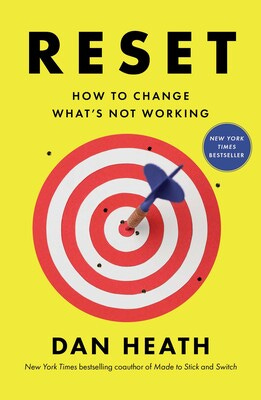Reset: How to Change What’s Not Working \ Dan Heath
“Every system is perfectly designed to get the results it gets.”
In Reset, Dan Heath delivers a sharp, eye-opening guide to solving stubborn problems by fixing the systems that create them. Whether it’s long drive-thru lines, high shelter euthanasia rates, or medication errors in hospitals, Heath shows that most failures stem not from bad people but from flawed systems. With real-world case studies, he urges readers to move past blaming individuals and start redesigning the processes behind poor outcomes.
This isn’t a book about working harder; it’s a book about working smarter—by changing the environment in which decisions are made.
Among the most surprising stories is that of Chick-fil-A. Faced with slow drive-thru times, the company didn’t overhaul their menu or build new lanes. Instead, they changed the sequencing of their process—sending employees with tablets outside to take orders sooner. That shift, simple but deliberate, dramatically improved throughput and customer satisfaction. (Though the brand has some of the highest wait times, their customer satisfaction scores are among the highest in the restaurant industry.)
Then there’s the case of 5 million cats. In shelters across the U.S., cats were routinely euthanized due to overcrowding. A Texas shelter flipped the script—not by finding more adopters, but by reducing intake. They realized most people didn’t want to give up their cats, so the shelter provided food, vet access, and support. The result? A stunning drop in admissions and euthanasia rates.
This upstream thinking—solving problems before they begin—is a central theme in Reset.
What’s the Big Deal?
Heath’s core message is that if you want better outcomes, stop blaming individuals and redesign the system. Fixing the environment where decisions are made is more powerful—and more sustainable—than trying to change behavior through training or rules alone. When you design with humans in mind, small changes can yield huge results.
Five takeaways
Upstream thinking prevents downstream disaster. Most organizations focus on reacting to problems. Heath challenges leaders to intervene earlier, addressing root causes before they create damage. In the shelter example, the goal shifted from saving cats inside the system to preventing them from entering it in the first place.
Fix the system, not the person. When things go wrong, we often blame individuals. Heath shows that consistent errors—like hospital drug mix-ups—usually point to systemic design flaws. One fix moved important medication labels to the top of IV bags, cutting dangerous mistakes dramatically.
Don’t let data distract you from design. Metrics matter, but they can anchor you to current assumptions. Heath encourages stepping back to ask better questions. Instead of tracking more adoptions, the animal shelter questioned why animals were arriving in the first place—and found a better intervention point.
Find and replicate bright spots. Don’t just analyze failures. Study outliers that succeed under the same conditions. A school, hospital, or store that outperforms peers can reveal replicable systems others can adopt.
Design for real people—not perfect ones. Humans forget, get tired, and make mistakes. Systems that expect ideal performance will break down. Heath highlights how thoughtful design—like visual cues, better defaults, and simplified processes—helps average people succeed consistently.
Reset is a playbook for anyone serious about lasting improvement. Whether you lead a team, run a business, or manage a household, the lesson is clear: change the system, and the results will follow. It’s a must-read for problem-solvers ready to stop reacting and start redesigning.




